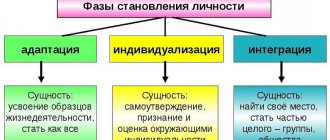Conflict is a confrontation between the interests of two parties, a difference in interests, needs or views. This is a normal part of a relationship, of course, provided it is resolved constructively. Conflicts happen in every family. There is even a typology of families based on the level of conflict. But first things first.
Types of families by frequency of conflicts
Depending on the frequency, depth and severity of conflicts in psychology, it is customary to distinguish families:
- Crisis. Conflicts between the needs and interests of spouses occur constantly, in every area. The partners are hostile towards each other and are unable to resolve the conflict constructively.
- Conflict. The interests of partners often conflict, but the spouses are capable, and most importantly want, to find a constructive solution.
- Problematic. Relations between spouses are strained, often escalate and are ready to take the form of conflict at any moment. This is caused by long-term unsatisfaction of the needs of family members.
- Neurotic. Families with high anxiety, tension, chronic and severe dissatisfaction, instability.
When do you need help from a psychologist?
How to resolve the conflict that has arisen? The first step is recognizing the problem. But even when the reason for the dispute is completely clear and there is an idea of how to get out of the crisis, many couples cannot come to a compromise.
Often, participants in a conflict see the situation one-sidedly and are not ready to see/hear/understand another point of view. Sometimes it requires the participation of a third, disinterested person who can take an unbiased look at different points of view and convey them to each of the partners. These are not moms, dads and friends, but a professional psychologist.
When it becomes clear that all conflicts in a relationship cannot be resolved on their own, it is better for the couple to turn to a specialist.
Types of family conflicts
- Conflicts can be open (quarrel, scandal, fight) and hidden (internal discontent, passive aggression).
- In addition, conflicts can be easily resolved (the cause and solutions are easy to find) and difficult to resolve (the problem is difficult to find, and after the solution, tension remains in the relationship).
- We can also distinguish between constructive and destructive conflicts. Destructive ones create long-term tension in the family, and the spouses become convinced that there is a real threat of divorce. Constructive conflicts force spouses to treat each other more carefully and strive to understand their partner.
Most often, conflicts arise at the so-called grinding-in stage, that is, at the beginning of a relationship, when spouses are just adapting to each other’s characteristics. At this stage, it is especially important to work through conflicts, find their causes and solve problems.
What kind of disagreements happen in a family?
The typology of family conflicts distinguishes two types of quarrels.
- Constructive are family conflicts, the peculiarity of which is that reconciliation brings a sense of satisfaction and relief to the two partners. The spouses find a compromise solution that will satisfy the interests of both parties.
- Destructive – features of family conflicts of this group in duration and lack of solution to the problem situation. Often in families where destructive quarrels arise, divorces occur.
Causes of conflicts
The cause of conflict is potentially any difference in views, needs, habits, or experiences. We all know that the cause of a conflict is always personally significant, and it is simply impossible to name all possible reasons. What is a reason for one couple is a reason to laugh for another.
The burden of family responsibilities, unsettled life, a new complex way of life - all this can provoke conflicts. It is noted that men suffer more due to difficulties in everyday life, physical and material matters. While women are more quickly undermined by the loss of romanticism, lack of respect and expressions of love on the part of their partner.
The most popular and generalized reason for failure is an inadequate attitude towards the ease of marriage. The basis of this attitude is unpreparedness for family relationships.
One way or another, conflicts arise due to the unmet needs of one or both spouses. In this context, the theory of V. A. Sysenko is of interest. The author identified the following causes of conflicts based on unmet needs:
- Unsatisfied need for the value and significance of the “I”. Arises as a result of disrespectful attitude on the part of a partner, insults, insults, and inadequate criticism. Manifests itself in conflicts and quarrels.
- Sexual dissatisfaction. The basis for this may be a mismatch of arousal cycles, low sexuality of one of the partners, overwork, illiteracy in matters of hygiene, illness and neuroses. Manifests itself in conflicts, disagreements, and mental stress.
- Dissatisfaction with the need for emotional intimacy: affection, care, attention, understanding. The reason is psychological alienation. Expressed by conflicts, quarrels, depression, mental stress.
- Addictions of one of the spouses that ruin the family (alcoholism, gambling addiction). Expressed in conflicts, quarrels, disagreements.
- Exaggerated needs of one of the spouses, which causes disagreements in matters of the family budget and the contribution of each spouse.
- Unmet basic needs (clothing, food) due to the personal needs of the other spouse. It is reflected in conflicts, quarrels, disagreements.
- Conflicting needs for cooperation, help, division of responsibilities at home or raising children. Manifests itself in conflicts.
- Different needs in matters of recreation. Because of this, conflicts, quarrels, and disagreements arise.
It is the needs that are primarily studied by a psychologist to help the family. Needs determine motives and interests, emotions, resistance to external stimuli. Depression and neuroses often have their roots in family discord.
The more stable your needs are, the more stable your marriage is. Communication between spouses should be emotionally positive. Neither spouse should experience a feeling of alienation and mental loneliness.
In a relationship, at least a minimum level of need satisfaction must be achieved. Otherwise, discomfort, negative emotions and feelings arise. With unmet or partially satisfied needs, physical and mental personal tension first arises, and then the emotional and psychological stability of the marriage begins to suffer. Unfortunately, sometimes the very personality of one spouse is an obstacle to meeting the needs of the other.
Hello, I'm your mother!
The Montagues and Capulets are nervously smoking on the sidelines when our Romeo's mother comes to visit for a week. This is where it turns out that Juliet rubs carrots incorrectly and doesn’t know how to iron shirts at all. Over the course of a week, the house is filled with a dozen jars of jam and other gifts of nature, and every dinner is accompanied by an immediate demand from the mother-in-law to urgently give birth to her grandson (preferably two). Not every love story can withstand the test of relatives who teach you wisdom, give all kinds of advice, and, moreover, believe they have the right to interfere in your personal life.
Conflict resolution
The structure of family conflict and the strategies of behavior in it are the same as in any other conflict. I would like to take a closer look at the strategies and their consequences for family conflict.
- Dominance. Doomed in advance to failure. Ignoring the interests and needs of your partner will further aggravate the situation.
- Withdrawal and avoidance. It will not resolve the conflict, but will transform it into chronic status. The family will be “treading water,” just like its members.
- Compliance. It will lead to a frustrated state of one of the partners, an imbalance in the relationship (rights, power, responsibilities). The family will become unstable and unstable.
- Compromise. More or less acceptable option, but not ideal. Mutual concessions take place, but in the depths of their souls, each spouse will have a sediment.
- Cooperation. The optimal solution to the conflict. Promotes personal growth of spouses, increased communication skills, development and strengthening of the family.
Strategy for handling a family quarrel
Conflict is always accompanied by a quarrel. But it can be used to your advantage. In psychology, there is a concept of a strategy for managing a family quarrel. This is a dispute between two loving people, in which the truth is born without accusations or harsh words.
- The first condition is that no one craves victory. Both want to resolve the contradiction. The defeat of one of the spouses is the defeat of the whole family.
- The second condition is to always respect your spouse, no matter how guilty he may be. Even in the most terrible rage, you need to remember how dear this person was to you just recently.
- The third condition is that after a quarrel, do not return to it, do not even mention its reasons.
When solving a problem, it is important to avoid maximalism and categorical judgments, and not to involve third parties (friends, children, relatives) in the conflict. Be honest with yourself about what is bothering you. Also honestly tell your partner about this.
Positive family therapy
If you cannot solve the problem on your own, then it is wise to visit a psychologist. Family positive psychotherapy is used to resolve family conflicts. The conflict is processed through 4 directions:
- bodily (sensation and perception);
- activity (mind and activity);
- social and communicative (contact, traditions);
- communication (imagination and intuition).
It is important that work in these areas is carried out in unity and consistency. The body will show how the situation is reflected, the social direction will introduce the experience of older generations, the imagination will make a forecast and present a solution, activity will bring it to life.
If one of the directions predominates, then the number of possibilities for solving the problem is significantly reduced. Moreover, various types of dysfunctions are noted:
- With a predominance of the physical – insomnia, drowsiness, eating disorders, psychosomatic diseases and sexual anomalies.
- When activity predominates, avoidance of the problem: passion for other activities (work, entertainment) or passivity and apathy, idleness. If the conflict is processed in this way, then the spouse’s inadequate self-esteem, fear of failure, and focus on results are noted.
- When the social direction predominates - avoiding the problem into superficial communication, company, or vice versa, avoiding any contacts and communication.
- Imagination, separately from other elements, takes a person into the unreal world of fantasies and illusions, dreams. This makes the conflict worse.
Why else is it important to consider family history? The author of this concept, N. Pezeshkian, identifies an actual and basic conflict. Current – what is happening in the family now. Basic – conflict in the family of the parents of one of the spouses, brought by him into his family.
To resolve the current conflict, you need to resolve the basic one, that is, understand how relationships were built in the parental family. Everything that influenced the development of the personality of the current spouses in childhood is important. We need to find the causes and object of the basic conflict and positively rethink it.
Division of labor
Romeo could at least every day dashingly climb onto the balcony to see his beloved. But would he be able to hammer a nail or fix a faucet or not - is that another question? Juliet will now have to do more than just bat her fluffy eyelashes, her responsibilities include daily cooking, as well as washing, cleaning... The couple will have to decide who will take out the trash and who will walk the dog or clean the aquarium. What if it turns out that they both grew up terribly spoiled and don’t even want to lift a finger to break their habit of being lazy. Here is your first adjustment, and the first real test for family life.









